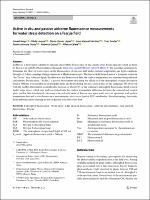Active in situ and passive airborne fluorescence measurements for water stress detection on a fescue field
Resumen
LEDFLEX is a micro-lidar dedicated to the measurement of vegetation fluorescence. The light source consists of 4 blue Light-Emitting Diodes (LED) to illuminate part of the canopy in order to average the spatial variability of small crops. The fluorescence emitted in response to a 5-μs width pulse is separated from the ambient light through a synchronized detection. Both the reflectance and the fluorescence of the target are acquired simultaneously in exactly the same field of view, as well as the photosynthetic active radiation and air temperature. The footprint is about 1 m2 at a distance of 8 m. By increasing the number of LEDs longer ranges can be reached. The micro-lidar has been successfully applied under full sunlight conditions to establish the signature of water stress on pea (Pisum Sativum) canopy. Under well-watered conditions the diurnal cycle presents an M shape with a minimum (Fmin) at noon which is Fmin > Fo. After several days withholding watering, Fs decreases and Fmin < Fo. The same patterns were observed on mint (Menta Spicata) and sweet potatoes (Ipomoea batatas) canopies. Active fluorescence measurements with LEDFLEX produced robust fluorescence yield data as a result of the constancy of the excitation intensity and its geometry fixity. Passive methods based on Sun-Induced chlorophyll Fluorescence (SIF) that uses high-resolution spectrometers generate only flux data and are dependent on both the 3D structure of vegetation and variable irradiance conditions along the day. Parallel measurements with LEDFLEX should greatly improve the interpretation of SIF changes.
Palabras clave
Representación
Sede Central
Editor
Photosynthesis Research
Es parte de
Photosynthesis Research
Status
openAccess
URI enlace
https://doi.org/10.1007/s11120-019-00642-9


